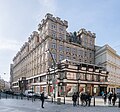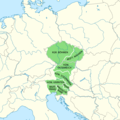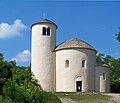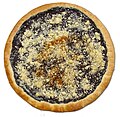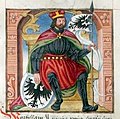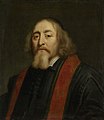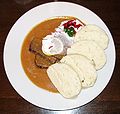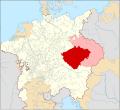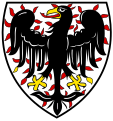Portal:Czech Republic
Welcome to the Czech Portal!
Vítejte na Českém portálu!

|

|
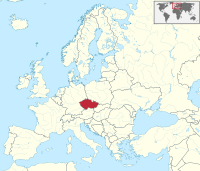
| |
The Czech Republic, also known as Czechia, is a landlocked country in Central Europe. Historically known as Bohemia, it is bordered by Austria to the south, Germany to the west, Poland to the northeast, and Slovakia to the southeast. The Czech Republic has a hilly landscape that covers an area of 78,871 square kilometers (30,452 sq mi) with a mostly temperate continental and oceanic climate. The capital and largest city is Prague; other major cities and urban areas include Brno, Ostrava, Plzeň and Liberec.
The Duchy of Bohemia was founded in the late 9th century under Great Moravia. It was formally recognized as an Imperial State of the Holy Roman Empire in 1002 and became a kingdom in 1198. Following the Battle of Mohács in 1526, all of the Crown lands of Bohemia were gradually integrated into the Habsburg monarchy. Nearly a hundred years later, the Protestant Bohemian Revolt led to the Thirty Years' War. After the Battle of White Mountain, the Habsburgs consolidated their rule. With the dissolution of the Holy Roman Empire in 1806, the Crown lands became part of the Austrian Empire.
In the 19th century, the Czech lands became more industrialized, and in 1918 most of it became part of the First Czechoslovak Republic following the collapse of Austria-Hungary after World War I. Czechoslovakia was the only country in Central and Eastern Europe to remain a parliamentary democracy during the entirety of the interwar period. After the Munich Agreement in 1938, Nazi Germany systematically took control over the Czech lands.
Czechoslovakia was restored in 1945 and three years later became an Eastern Bloc communist state following a coup d'état in 1948. Attempts to liberalize the government and economy were suppressed by a Soviet-led invasion of the country during the Prague Spring in 1968. In November 1989, the Velvet Revolution ended communist rule in the country and restored democracy. On 31 December 1992, Czechoslovakia was peacefully dissolved, with its constituent states becoming the independent states of the Czech Republic and Slovakia.
The Czech Republic is a unitary parliamentary republic and developed country with an advanced, high-income social market economy. It is a welfare state with a European social model, universal health care and free-tuition university education. It ranks 32nd in the Human Development Index. The Czech Republic is a member of the United Nations, NATO, the European Union, the OECD, the OSCE, the Council of Europe and the Visegrád Group. (Full article...)
Selected article -
Theresienstadt Ghetto was established by the SS during World War II in the fortress town of Terezín, in the Protectorate of Bohemia and Moravia (German-occupied Czechoslovakia). Theresienstadt served as a waystation to the extermination camps. Its conditions were deliberately engineered to hasten the death of its prisoners, and the ghetto also served a propaganda role. Unlike other ghettos, the exploitation of forced labor was not economically significant.
The ghetto was established by the transportation of Czech Jews in November 1941. The first German and Austrian Jews arrived in June 1942; Dutch and Danish Jews came at the beginning in 1943, and prisoners of a wide variety of nationalities were sent to Theresienstadt in the last months of the war. About 33,000 people died at Theresienstadt, mostly from malnutrition and disease. More than 88,000 people were held there for months or years before being deported to extermination camps and other killing sites; the role of the Jewish Council (Judenrat) in choosing those to be deported has attracted significant controversy. The total number of survivors was around 23,000, including 4,000 deportees who survived. (Full article...)Selected picture

Photographer: Milan Nykodym, Czech Republic; License: Creative Commons CC-BY-SA
In this month
- 2 June 1541 – A fire destroys much of Malá Strana and the northern part of Prague Castle
- 10 June 1348 – The foundation stone of Karlštejn Castle (pictured) is laid
- 20 June 1976 – The Czechoslovakia national football team win UEFA Euro 1976
- 23 June 1955 – The first national Spartakiad is held, marking ten years after the nation's liberation at the end of World War II
- 30 June 1945 – State security service StB is established
Categories
Selected biography -

Emanuel Moravec (Czech pronunciation: [ˈmoravɛts]; 17 April 1893 – 5 May 1945) was a Czech army officer and writer who served as the collaborationist Minister of Education of the Protectorate of Bohemia and Moravia between 1942 and 1945. He was also chair of the Board of Trustees for the Education of Youth, a fascist youth organisation in the protectorate.
In World War I, Moravec served in the Austro-Hungarian Army, but following capture by the Russians he changed sides to join Russian-backed Serbian forces and then the Czechoslovak Legion, which went on to fight on the side of the White Army in the Russian Civil War. During the interwar period he commanded an infantry battalion in the Czechoslovak Army. As a proponent of democracy during the 1930s, Moravec was outspoken in his warnings about the expansionist plans of Germany under Adolf Hitler and appealed for armed action rather than capitulation to German demands for the Sudetenland. In the aftermath of the German occupation of the rump Czechoslovakia, he became an enthusiastic collaborator, realigning his political worldview towards fascism. He committed suicide in the final days of World War II. (Full article...)Did you know?

- ...that the Sedlec Ossuary is a chapel decorated with the bones of 40,000 people?
- ... that the Cross of Merit of the Minister of Defence of the Czech Republic is the highest award presented by the Czech Minister of Defence?
- ... that Czech international footballer Patrik Gedeon went to play club football in Liechtenstein in the middle of his career?
- ... that a 1926 voyage to Java inspired Czech poet Konstantin Biebl for the remainder of his life?
General images
Related portals
Topics

Czech lands: Bohemia • Moravia • Czech Silesia
History: Únětice culture • Boii • Marcomanni • Samo • Great Moravia • Přemyslid dynasty • Lands of the Bohemian Crown • Czech lands (1526–1648) • 1648–1867 • 1867–1918) • Czechoslovakia • Czech Republic
Geography: Lakes • Protected areas • Regions • Rivers
Law: Judiciary • Law enforcement • Supreme Court of the Czech Republic
Politics: Administrative divisions • Government • Constitution • Elections • Foreign relations • Army • Parliament • Political parties • President • Prime Minister
Economy: Banks • Czech koruna • Energy • Oil and gas deposits • Stock Exchange • Tourism • Transport
Culture: Architecture • Art • Cinema • Cuisine • Demographics • Education • Language • Literature • Media • Music • Philosophy • Prostitution • Public holidays • Religion • Sport • Television • Video games
Symbols: Flag • Coat of arms • National anthem (Kde domov můj)
Lists: Outline of the Czech Republic • List of Czech Republic–related topics
WikiProjects
Featured and good content
Things to do
Wikimedia
The following Wikimedia Foundation sister projects provide more on this subject:
-
Commons
Free media repository -
Wikibooks
Free textbooks and manuals -
Wikidata
Free knowledge base -
Wikinews
Free-content news -
Wikiquote
Collection of quotations -
Wikisource
Free-content library -
Wikiversity
Free learning tools -
Wikivoyage
Free travel guide -
Wiktionary
Dictionary and thesaurus












